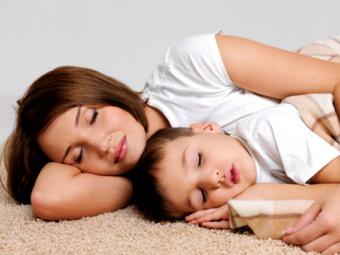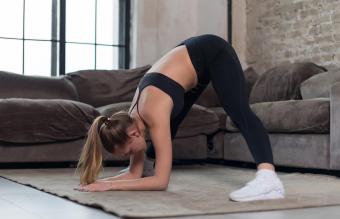
There are many theories that suggest using yoga Nidra for children might encourage better relaxation and clearer thinking.
How Yoga Nidra May Help
Also known as "the sleep of the yogis", Yoga Nidra is a state of being that is not really sleep, but not exactly fully conscious, either. Often considered a form of meditation, it's the practice of guiding your entire body and mind into complete relaxation.
Yoga Nidra for children can be a helpful method to help them calm down after a particularly long day, prompt better sleep if they have trouble nodding off, and even provide a respite from studying if they're having difficulty concentrating. Some people also believe that children with disabilities and learning and behavior disorders benefit from a yoga Nidra practice. Learn more on the Yoga Journal Web site.
Step-by-Step Practice of Yoga Nidra for Children
When you first introduce the idea of focusing on each body part to calm down, preschoolers might wiggle, eight-year-olds may giggle, and teens will probably roll their eyes. But, most children do find quiet moments refreshing, even if they don't think it helps at the time.
Here are some introductory steps for yoga Nidra for children:
- Create an atmosphere that is quiet with dim lighting, but not dark. Shut off all electronics - even the low hum of a desktop computer can be distracting.
- Have the child lie flat on his or her back, arms away the sides, palms facing up.
- Gently cover the eyes with a dry, warm washcloth.
- Start the relaxation process by asking the child to focus on his or her breath. On the inhale, ask the child to fill his or her body with a favorite color. On the exhale, release the color and the breath. Do this three times.
- Next, have the child tighten all his or her muscles at once, even making a fist, then release all at once. Do this three times.
- Ask the child to imagine something such as the sun, the moon, a star, sand, bubbles, or warm bathwater.
- Starting with the toes, ask the child to imagine that whatever he or she chose above is touching that body part.
- Slowly move up the body: toes, ankle, foot, calf, knee, and so on for all the parts of the body. When the image touches the body part, it fills it with the light of the child's favorite color.
- Move up the entire body to the head, which also fills with color.
- Give the child a minute or two (depending on age) to feel that his or her body is filled with color.
- Then, ask the child to roll to one side, remove the washcloth but leaving the eyes closed, and wait a moment before sitting in a cross-legged position. Then, open the eyes.
With younger children, the body parts are more general. With older children, you can focus on left side, right side, fingertips, hips, and so on.You may want to use music as a cue to move through the practice, such as a small bell or wind chime. You might also want to encourage the child to talk about what he or she experienced, or draw a picture of it. With older children, incorporate positive affirmations or a trigger to release bad feelings or anxiety.
The length of the practice varies depending on the age of the child. If you have a preschooler and can get him or her to do this for two minutes, that's great! Grade school children should be able to do this for up to five minutes, and older children may want up to a 15-minute respite.
Yoga Nidra CDs
You and your children might find yoga Nidra CDs a helpful way to learn this practice together. You may also want to preview each CD to make sure it's a suitable length and subject matter for your child's level of yoga experience.
While there aren't any yoga Nidra CDs specifically for children, you may want to play one of these CDs in segments, or use them as guides as you encourage your children into a more peaceful state:
- Yoga Nidra Meditation CD: Extreme Relaxation of Conscious Deep Sleep
- Yoga Nidra Meditation: Chakra Theory and Visualization
- Meditation and Yoga Nidra (Relaxation and Stress Reduction, Healing and Rejuvenation
Here are a few suggestions for relaxation CDs for children that, while not yoga Nidra, may help you eventually develop a full practice:
- Indigo Ocean Dreams by Lori Lite helps children relax and find better ways to deal with negative emotions. The author also developed Indigo Teen Dreams.
- Rainbow Sunshine Relaxation Mind-Body CD is for children ages 6-11 who need help to relax and fall asleep. Designed for children undergoing everything from medical procedures to everyday stress, it encourages a stronger mind-body connection.
- Positive Thoughts for Children by Chitra Sukhu combines music and positive affirmations to promote a better state of wellbeing.







